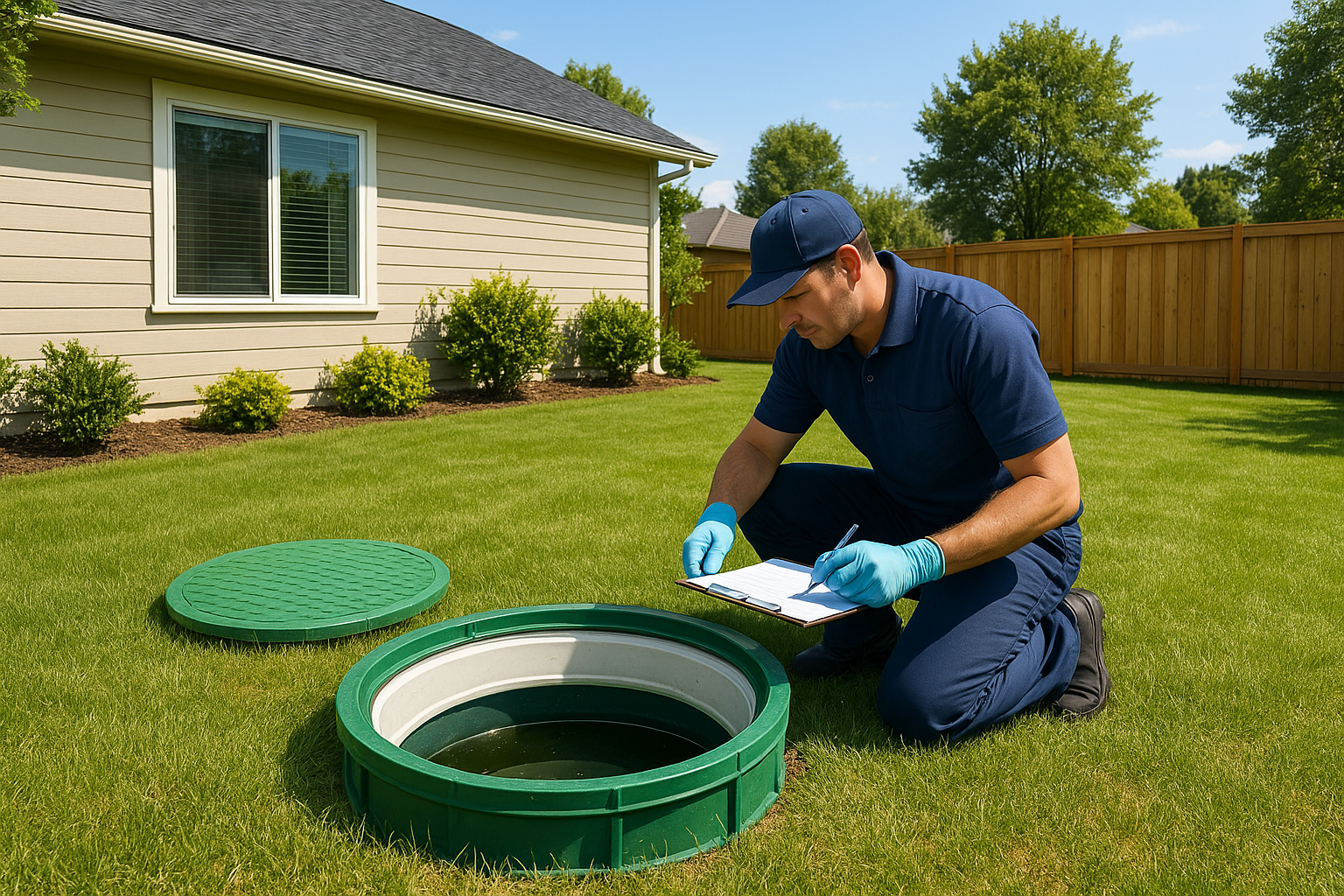Have you ever wondered what really happens during septic tank cleaning or why it’s necessary? Many homeowners tend to overlook this essential maintenance task until an unpleasant odor, slow-draining sinks, or pooling water around the tank area signals that it’s time. Keeping up with septic system care not only prevents messy emergencies but also saves you from expensive repairs that can arise if small problems are ignored. A properly maintained system ensures your home remains sanitary and your plumbing operates efficiently, protecting your family’s health and overall property value.
This guide provides a detailed, step-by-step walkthrough of the septic emptying process, helping you understand what goes on beneath your yard. Whether you’re new to septic systems, recently purchased a home with a tank, or just need a refresher, this article will give you the confidence to stay on top of your system’s needs. Regular attention, through following septic maintenance tips and keeping up with your septic maintenance checklist, can significantly extend the life of your system.
By the end of this walkthrough, you’ll understand what to expect when scheduling professional septic service, from preparation to cleanup. You’ll also gain insights to make the process smoother and more efficient, ensuring your system stays functional for years. Avoiding neglect and staying informed through septic system inspection and septic sludge management is the key to long-term performance and environmental safety.
Understanding Septic Systems and Their Role
Septic systems are often misunderstood, yet they play a critical role in managing household wastewater, especially in homes located far from municipal sewer networks. At its core, a septic system guide explains that a watertight tank collects wastewater from sinks, showers, and toilets. Solids settle at the bottom as sludge, oils and grease form a scum layer at the top, and the liquid effluent flows into the drain field for natural filtration. Think of this as a miniature sewage removal service quietly working beneath your yard, protecting your home and the surrounding environment.
Key concepts like sludge, effluent, and sludge extraction steps are important to know. Understanding these allows you to spot potential issues early and schedule timely septic tank inspection. Modern drain field maintenance practices and eco-friendly technologies ensure that septic systems function efficiently and comply with environmental regulations. Many homeowners now incorporate DIY septic cleaning habits, carefully monitor water usage, and follow the recommended septic pumping procedure to prevent overload or system failures.
Proper septic waste disposal is a crucial part of responsible homeownership. Following best practices not only protects groundwater and soil but also reduces the risk of costly repairs. By understanding where septic systems came from, how they operate, and why regular septic maintenance service is necessary, homeowners are better prepared to handle the septic emptying process. A solid foundation of knowledge makes maintaining your system less intimidating and more manageable over the long term.
Breaking Down the Septic Tank Emptying Process
Emptying a septic tank may seem straightforward, but it involves multiple steps that protect your plumbing, property, and the environment. Knowledge of the process helps homeowners avoid unnecessary problems and make the most of professional septic service. Understanding what happens ensures the work is done efficiently and that your system remains in good condition for years.
- Inspection and Preparation – Professionals or septic pumping experts locate your tank, check for cracks or leaks, and prepare the surrounding area to prevent spills or yard damage.
- Pumping the Tank – Using specialized septic cleaning equipment, sludge and scum are removed as part of the waste removal procedure. This is a crucial step in avoiding backups and maintaining system efficiency.
- Visual Assessment – After pumping, technicians examine the interior for potential issues that may require septic tank repair, such as cracks, root intrusion, or other structural damage.
- Waste Disposal – Removed waste is safely transported to approved treatment facilities, following local environmental and regulatory guidelines.
- System Check & Recommendations – Technicians provide septic maintenance tips and guidance for water usage or system improvements, helping homeowners implement ongoing residential septic care.
For a deeper breakdown of each step, explore this septic tank emptying guide for more insights into proper maintenance and care.
Key Benefits of Regular Septic Tank Emptying
Maintaining your septic system provides numerous long-term benefits that protect both your home and the environment. Staying proactive through septic pumping guide methods ensures your system continues to function efficiently and reduces the likelihood of expensive emergency repairs.
- Prevents Costly Repairs – Regular pumping removes sludge and scum buildup before it causes damage, keeping pipes clear and avoiding unexpected emergency septic service calls.
- Protects Home and Yard – Proper care prevents foul odors, sewage leaks, or soil contamination, preserving landscaping and keeping your property safe.
- Extends System Lifespan – Effective septic sludge management allows your tank and drain field to work efficiently for many additional years.
- Supports Environmental Health – Responsible septic waste disposal minimizes the risk of groundwater contamination and supports local ecosystems.
- Peace of Mind – Knowing your system is well-maintained reduces stress and gives you confidence that your home plumbing is functioning correctly.
To learn about costs associated with this routine maintenance, check this detailed guide on septic tank emptying costs in 2025 for budget planning and smart scheduling.
Common Challenges and Solutions
Even routine septic tank servicing can present challenges. Common obstacles include scheduling, upfront costs, hard-to-access tanks, unpleasant odors, and reliance on misleading DIY solutions. Understanding these issues and planning proactively ensures a smoother maintenance experience.
- Plan Ahead – Schedule regular appointments every 3–5 years or as recommended locally to prevent emergency situations.
- Budget – Account for maintenance costs in household expenses to avoid unexpected financial strain.
- Ensure Access – Keep lids clear or install risers for easy septic system inspection checklist use, reducing time and labor costs.
- Hire Reputable Professionals – Research reviews and select experienced providers to ensure thorough, safe, and efficient cleaning.
If emergencies arise, refer to septic emergency tips to address issues quickly and safely.
Putting Septic Tank Maintenance into Action
Taking proactive steps helps homeowners avoid costly issues and maintain residential septic care. Following a structured plan ensures your system remains efficient and safe.
- Locate your tank using property records or septic tank emptying services near you.
- Review your maintenance records and consult your septic emptying schedule guide for consistency.
- Schedule emergency septic service or regular pumping with a professional septic service.
- Clear access to the tank for septic cleaning equipment use.
- Discuss findings with technicians and apply recommended septic maintenance tips.
- Maintain a calendar following your checklist to stay proactive.
Using these resources ensures you never miss critical maintenance intervals and can act before issues escalate.
The Future of Septic Tank Maintenance
Septic care is evolving with technological advances, eco-friendly solutions, and stricter regulations. Trends in professional waste removal and septic system solutions are making maintenance easier, safer, and more efficient for homeowners.
Smart monitoring systems can alert you to high tank levels or leaks. Eco-friendly biological treatments enhance waste breakdown while protecting groundwater. Automated scheduling integrates with service providers, streamlining routine maintenance. Facilities are converting waste into renewable energy or fertilizer, supporting environmental sustainability. Stricter regulations ensure all systems meet safety and ecological standards.
For homeowners who want reliable service options, explore local septic tank emptying services near you to find certified professionals in your area.
Wrapping Up
We’ve explored everything from septic sludge removal and septic emptying process steps to long-term benefits. Regular care, troubleshooting, and scheduling servicing protect your home, your wallet, and the environment. Start today by reviewing records, contacting experts, and implementing proactive care. Fewer emergencies, safer water, and a well-maintained system are the rewards.
A Final Word on Caring for Your Septic System
Maintaining your septic tank may not be glamorous, but it’s essential. Utilize DIY septic cleaning where safe, follow maintenance tips, and rely on septic tank emptying services near you to keep your system functioning properly. Small, consistent actions today prevent costly repairs tomorrow, ensuring long-term reliability and peace of mind.






